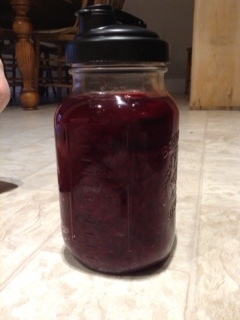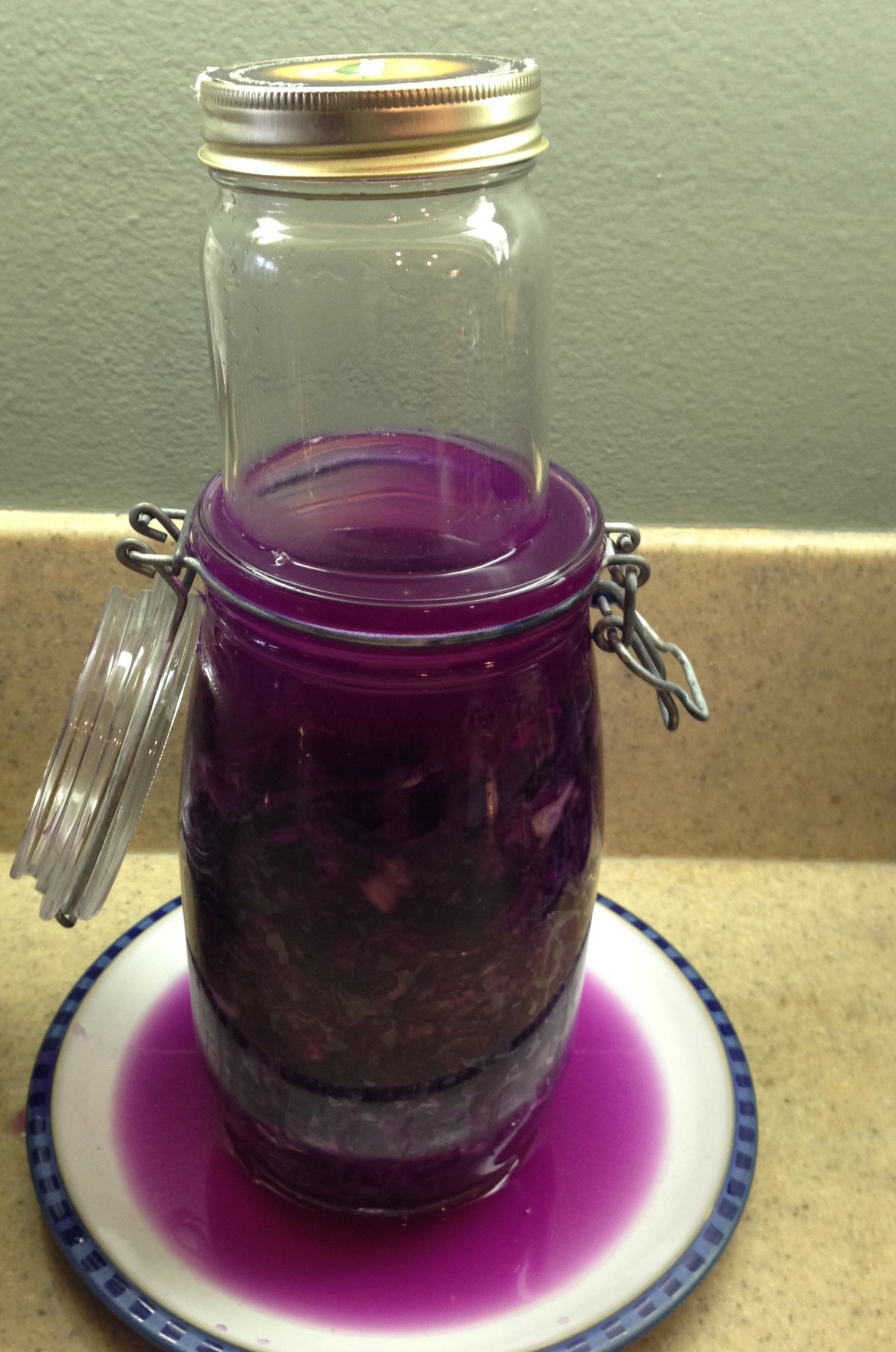Greetings!!
I followed the book “fermented vegetables” and it seemed my ferment was ready at five days.
I didn’t want it too sour/“nasty” (my husband and a dear friend were skeptical at letting it sit too long) so i tasted it and jarred it up. it’s in the fridge. My first kraut. Naked kraut.
Do you think I rushed it?
We keep our house at 65F year round and i had this in a crock in my sewing room above our boiler room.
Thank you!!!!***********************
Hi there,
Congratulations on your first Naked Kraut. Sorry for the slowish response. We have been traveling a lot. These look great. I am guessing you are enjoying them by now. As soon as the kraut smells pickley then it is technically done. As the time increases it just gets more sour. The only reason to let it go more is that it will continue to process the carbohydrates and “predigest” them for you. That said these younger ferments are super tasty and still good for you.
Enjoy,
Kirsten
Cabbage Leaves Blackening?
Hi.
I am making sour cabbage leaves for cabbage rolls and using old Baba recipe which is very loosely-goose as to amount of salt and water. Smells like they are fermenting but outer leaves appear to be blackening! Yikes! Why? And are they still salvageable?
Thanks, Kathy
*********************
HI Kathy,
These look okay to me, I don’t see they “blackening” but I do see the deep color I think you are referring to, this is just the color that the greener outer leaves get. Think of the color of an olive or dill pickle. Green turns that army style green.
I think as long as you keep them submerged until they are fully fermented they will be fine.
I hope that helps,
Kirsten
The scum looks funky, is it okay?
Hi,
We started fermenting some red cabbage in a 10L crock about two weeks ago. Over the weekend, my husband realized that he had not checked the water seal on the lid in quite some time, and, alas, it was completely dry. The cabbage has been under weights, but the top of the brine looked pretty funky (see photos). Did we ruin our batch?
Thanks for your advice,
Amanda
******************************
Hey Amanda,
Funky but fine!
When you are ready to eat you will skim that off as best you can, there is actually nothing harmless in that funk that you are looking at, taking the weights out carefully as you go will help you to remove all that.
I am positive you will see a beautiful pink kraut underneath. :)
Cheers,
Kirsten
Salt and Fermentation
Why? How much? What kind? of salt do I need for fermentation?
Salt seems to cause a lot of consternation for the new fermentista so I thought I would add a salt post to troubleshooting fermentation.
Salt doesn't preserve
First the salt doesn’t preserve the veggies the acidification of the process does so if you are worried about "killing yourself" more salt doesn't make it safer. (Keeping it under the brine does.) What the salt does is give the good bacteria (#lactobacillus) the upper hand to get started and once these guys get going they quickly overwhelm any "bad" bacteria with their acidic output.
Crispy and Tasty
Salt also hardens the pectins (that’s your crisp) and slows down the fermentation a bit, which can be important in hot climates or if you are storing without refrigeration. Salt also makes your ferment taste better, remember salt is a flavor enhancer. Of course too much salt and it is no longer tasty. Choose a mineralized salt you love, taste your ferment for saltiness—should be salty like a chip not briny like a mouthful of seawater. Most importantly — It should be tasty!
What kind of salt?
What kind of salt is personal preference though I don’t use processed industrialized salts, like pickling salt, etc.
How much salt?
This is where things get confusing. The truth is I never measure my own ferments, for me it feel but I do measure and now even weigh the veggies and salt when I am developing a recipe for others. I try to stick to a 1.5 % ratio by vegetable weight. This is enough to do what salt needs to do. Many recipes go as high as 5% and for me that is way too salty and doesn’t make the ferment any safer. So there is a lot of variability!
If you read older recipes you will see things like "packed in salt" or amounts that are crazy high. This is because they had to keep their ferment working a little slower because it stayed in a cool spot like a basement all winter and never was slowed down by a refrigerator. They also did not have as much salt in their regular diet as we do now so it wasn't a problem in many cases the ferment contained the salt that was added to an otherwise bland, starch-based meal.
I have over-salted, does the salt go away?
Somewhere the myth that the salt in a ferment goes away is out there alive and well. Sorry to report it has no where to go--too much salt continues to be too much salt. (In fact if anything a long ferment could evaporate slightly thereby concentrating the salt.)
Thick Sticky Beet Brine
Hello Kirsten.
The brine on my beets is very thick and slimy.
They did not bubble very much for the three days I had them fermenting.
I wonder if I packed them too much?
And if they are safe to eat.
They are crispy and do taste OK but I'm worried. This is my first attempt at fermenting.
My thanks for this help.
Merilyn
__________
Hi Merilyn,
Beet brine is very thick and viscous because beets have so much sugar. The other thing is that 3 days isn’t very long for a ferment like this and sometimes there is a thick slimy phase in fermentation that will work itself out. The picture I am sending is a ferment that is fine but went through this slimy phase. It happens sometimes.
I think you are fine and that they are very safe. The important thing to remember is that if they are bad (as in unsafe) they will be awful smelling and tasting too.
I would let them ferment a little longer and realize beets are also just like that to a point. I hope that helps.
Cheers,
Kirsten
This sauerkraut was fine, it smelled good and had no scum. The problem was the viscous brine. It was quite unappealing. This happened because the ferment had been fermenting very slowly at temperatures in the low 50° F range. We advised the maker of this kraut to move it into a warmer space and ferment it longer and Violá it worked! The kraut was perfect in a few days.
White Ring on the Bottom of a Ferment Jar
Hello Kirsten,
I've recently made a bottle of spinach kraut by following one of your recipes. And when it was done, I put it into the fridge. Only after a few days, I saw a "white ring" at the bottom of the bottle. I've attached a picture here to explain better. Do you know why that happened? And is it still safe to eat?
Thanks,
Tracy
Hi Tracy,
The white ring at the bottom of your ferment it fine and a normal part of fermentation. It is similar to the sediment at the bottom of pickles (like Bubbies brand or home fermented pickles). I am happy to report it is very normal and harmless. I believe you are seeing it because the spinach ferment is darker in color than most. If you look carefully at other ferments you will likely see a similar ring.
Cheers,
Kirsten
Here is another troubleshooting question about sediment with the same advice, but maybe that one looks more like yours than this one.
If you would like to learn how to make sauerkraut or pickles we have a couple of courses now available at our fermentation school:
Mastering Fermented Vegetables It covers it all. This complete vegetable fermentation course will teach you the skills and give you the confidence to ferment any vegetable safely and effectively.
Learn to Make Fermented Hot Sauces Learn to ferment hot sauce with any pepper you love. You can choose blazing hot or super mild peppers, fresh or dry and blend in other flavors. This fermentation class will teach you everything you need to make your own safe probiotic hot sauces.
Learn to Ferment Sauerkraut and Pickles In this class we will walk you through making your own delicious lacto-fermented sauerkraut and pickles. This class is a benefit for the displaced folks from the Sept 9, 2020 Fires in Southern Oregon. All proceeds will go to good food aid.
Can I still eat this sauerkraut?
Question :: When I pulled this beet sauerkraut out of the back of my refrigerator I found this this white growth on top. Is it still safe to eat? — Jane, CA
Answer :: It looks like you have two things happening on the top of the sauerkraut. The first is kahm yeast which is harmless but it makes the flavor quite "yeasty". The other issue appears to be mold. This is something you do not want to eat. Both of these things happen with the exposure to air and can be avoided by pressing your sauerkraut under the brine before storage. Also always use clean utensils.
Because of the condensation on the container it is difficult to see the sauerkraut that is under the affected area. It appears there are air bubbles throughout the kraut. If this is the case the entire batch may have been exposed to air in which case the molds and yeasts can move throughout the kraut. This sadly means it must move on to the compost pile.
When you are faced with a sauerkraut that has something undesirable on top you do not always need to throw the whole thing away. Often it is just the top layer and maybe the first inch of sauerkraut that must be composted. Everything under the brine is anaerobic and safe to eat.
The best thing to understand is if it is bad you will know it is bad. Flavor, color, smell—all your senses will let you know.
At the fermentation school Kirsten offers a simple Learn to Ferment Sauerkraut and Pickles class for $16, Learn to Make Fermented Hot Sauces for $35, a Mastering Fermented Vegetables for $78 and a special bundle of the last two for a discounted price of $93.
Is my brine fine?
Question :: "This brine keeps overflowing! I put the batch in a larger jar and submerged it was another jar of water like you mentioned, but the brine keeps spilling out. How does volume increase like this? Just expanding? Oh wait, I pushed down on it, and it released a ton of bubbles. So I was able to pour that brine back in, and it seems like I'll just keep doing that? Should I put it in divided jars?"
Answer :: You are right that pressing it down and letting the brine sink back into the cabbage is what needs to be done. The jar is quite full and so there isn't much room to accommodate the action. You will need to press it down regularly, or you can press it into a larger jar. Thanks for the photo!
As far as the CO2 action you are seeing--it is different all the time. Some cabbage batches are not as active as well…its a funny thing and hard to predict. The good news is even the quiet ones are working.















